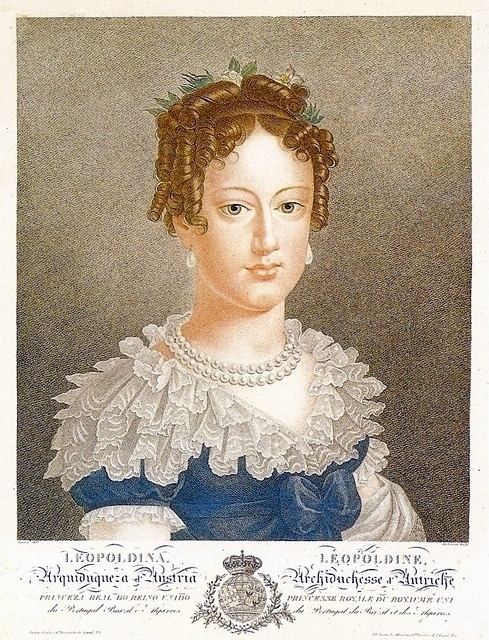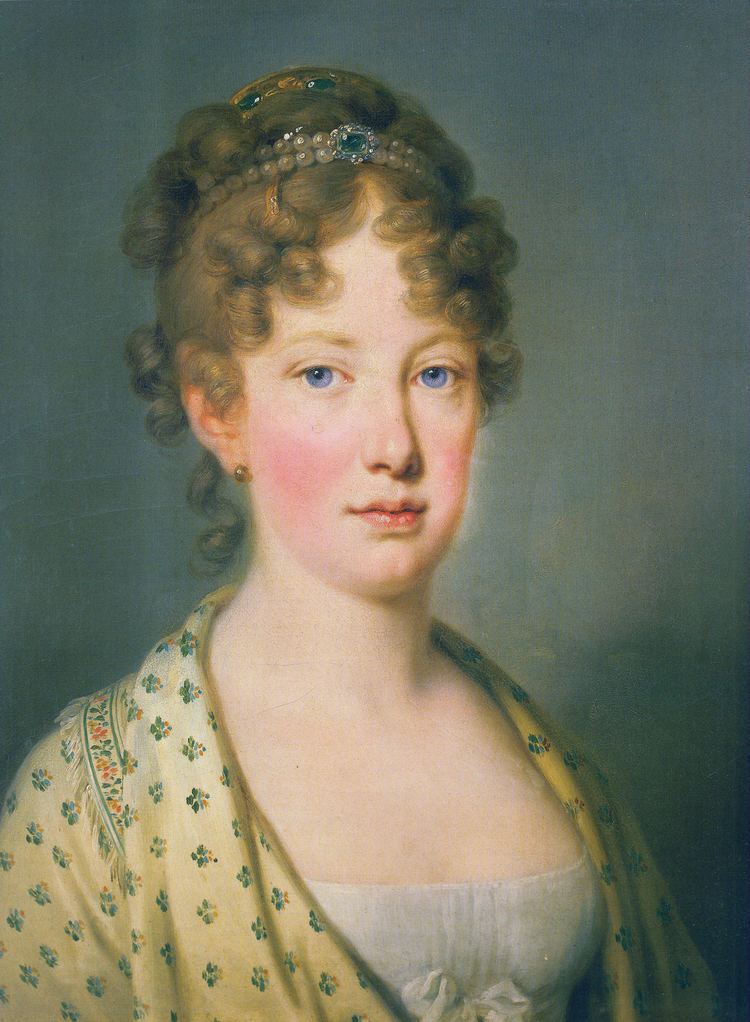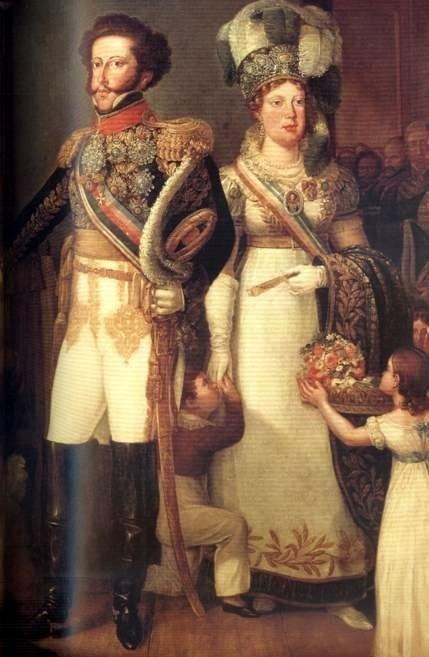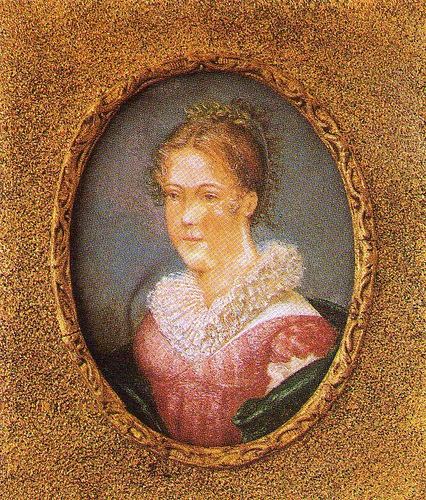Name Maria of | ||
 | ||
Tenure 12 October 1822 – 11 December 1826 Tenure 10 March 1826 – 2 May 1826 Issueamong others... Maria II of PortugalPedro II of BrazilPrincess Francisca of BrazilPrincess Januaria of Brazil Mother Maria Teresa of Naples and Sicily Died December 11, 1826, Paco de Sao Cristovao Spouse Pedro I of Brazil (m. 1817–1826) Children Pedro II of Brazil, Maria II of Portugal Parents Maria Theresa of Naples and Sicily, Francis II, Holy Roman Emperor Similar People | ||
Dom pedro ii no brasil document rio completo dublado filmes series desenhos animes
Dona Maria Leopoldina of Austria (22 January 1797 – 11 December 1826) was an archduchess of Austria, Empress consort of Brazil and Queen consort of Portugal.
Contents
- Dom pedro ii no brasil document rio completo dublado filmes series desenhos animes
- Early life
- Marriage to Pedro
- Empress of Brazil
- Titles and styles
- Depiction in media
- References

She was born in Vienna, Austria, as the daughter of Holy Roman Emperor Francis II, and his second wife, Maria Teresa of Naples and Sicily. Among her many siblings were Emperor Ferdinand I of Austria and Marie Louise, Duchess of Parma, the wife of Napoleon Bonaparte. She was also the great-niece, through her paternal grandfather and maternal grandmother, of the ill-fated Queen Marie Antoinette of France.

Early life

Leopoldina was born on 22 January 1797 in Schönbrunn Palace, in Vienna, Archduchy of Austria. She was given the name Caroline Josepha Leopoldine Franziska Ferdinanda, according to her biographer Carlos H. Oberacker, and confirmed by Bettina Kann in her work "Cartas de uma Imperatriz", who mentioned a contemporary source: the Austrian newspaper Wiener Zeitung of 25 January 1797, who gave the news of the birth of the Archduchess three days before with her full name. According to Oberacker, the name "Maria" wasn't present in the preserved baptismal record of the Archduchess, and she began to use it only during her journey to Brazil, where she began to be named Maria Leopoldina in all documents, including the Constitutional oath of 1822. According to another theory presented by Oberacker, the Archduchess probably began to use the name "Maria" due to her great devotion to the Virgin Mary and because all her sisters-in-law used this name.

She was raised in accordance with the educational principles laid down by her grandfather, Emperor Leopold II. Among these was the habit of exercising her handwriting by writing the following text:

In addition, she and her sisters were taught to speak French and Latin. They were also educated in drawing, piano, riding and hunting. Her mother died when she was ten years old and her father went on to remarry Maria Ludovika of Austria-Este. Her late mother was a soprano and Leopoldina had the chance of meeting Johann Wolfgang von Goethe in 1810 and 1812, when she went to Carlsbad with her stepmother. Her passions included natural sciences, especially botany and mineralogy. She was formed according to the three Habsburg principles: discipline, piety and a sense of duty.
Although Maria Theresa of Naples and Sicily was her birth mother, Leopoldina always considered Maria Ludovika d'Este, her stepmother, to be her mother and she grew up with Ludovika as her "spiritual mother".
Marriage to Pedro
On 24 September 1816 it was announced by Leopoldina's father that Pedro of Braganza wished to take a Habsburg princess as his wife. Klemens von Metternich suggested that it should be Leopoldina to go get married, as it was "her turn" to become a wife. Two ships were prepared and in April 1817 scientists, painters, gardeners and a taxidermist, all with assistants, travelled to Rio de Janeiro ahead of Leopoldina, whom, in the meantime, studied the history and geography of her future home and learned Portuguese. During these weeks Leopoldina compiled and wrote a vade mecum, a unique document the like of which has never been produced by any other Habsburg princess.
On 13 May 1817 Leopoldina was married to Dom Pedro per procuram (by proxy) in Vienna. At the ceremony the bridegroom was represented by Leopoldina’s uncle, Archduke Charles. Embarkation took place in Livorno on 13 August 1817 among much celebration, and after an adventure-filled voyage lasting 81 days, Leopoldina arrived in Rio de Janeiro on 5 November and finally met her husband.
From a distance Pedro initially appeared to Leopoldina to be a perfect, well-educated gentleman, but the reality was very different. Dom Pedro was a year younger than Leopoldina and sadly rarely measured up to the descriptions given by the matchmakers. His temperament was impulsive and choleric, and his education but modest. Even spoken communication between the young married couple proved difficult, as Pedro spoke very little French and his Portuguese could only be described as vulgar.
In keeping with Portuguese tradition, at the age of eighteen Pedro of Braganza not only had a string of amorous adventures behind him and was principally interested in horse racing and love affairs, but in 1817 (the year of his marriage to Leopoldina) he was living as if in wedlock with French dancer Noemie Thierry, who was finally removed from the court by his father a month after Leopoldina's arrival in Rio de Janeiro.
The young married couple took up residence in six relatively small rooms in the Palace of São Cristóvão. The inner courtyard and path to the stables were unpaved and the tropical rainfall quickly turned everything to mud. There were insects everywhere, including in their clothing, for the uniforms and court regalia made of velvet and plush rotted and turned mouldy in the heat and humidity.
Empress of Brazil
Maria Leopoldina became Brazil's first empress consort. She also played an important role in the process of issuing a Declaration of Independence. On 2 September 1822, a new decree with demands from Lisbon arrived in Rio de Janeiro, while Prince Pedro was in São Paulo. Leopoldina, advised by José Bonifácio, and using her power as Princess Regent, met on 2 September 1822 with the Council of Ministers. She decided to send her husband the news along with a letter advising him to declare Brazil's independence and warned him, "The fruit is ready, it's time to harvest." Prince Pedro declared the country's independence upon receiving the letter on 7 September 1822.
When his father, João VI, died on 10 March 1826, Pedro inherited the Portuguese throne as King Pedro IV, while remaining Emperor Pedro I of Brazil. Maria Leopoldina thus became both Empress consort of Brazil and Queen consort of Portugal. However, two months later, Pedro was forced to give up the Portuguese throne to their seven-year-old daughter Maria.
At the end of November 1826, Pedro traveled to Cisplatina (now Uruguay) to join his soldiers. To mark the occasion there was a large farewell reception on 20 November 1826, and Pedro demanded that both women, Maria Leopoldina and his official mistress Domitila de Castro, Marchioness of Santos, appear together before the ecclesiastical and diplomatic dignitaries and receive his kiss on the hand. With the fulfillment of this demand, Maria Leopoldina would have officially recognized her husband's mistress, and for this she refused to appear at the reception. This caused a bitter argument with Pedro, who departed with no resolution to the situation.
Shortly after, Maria Leopoldina became ill, had spells of fever, became delirious at times, and then suffered a miscarriage on 2 December 1826. She died eight days later, on 11 December, five weeks before her thirtieth birthday. She was buried on 14 December 1826 in Rio de Janeiro, in the church of the Ajuda Convent.
Titles and styles
Depiction in media
Maria Leopoldina is portrayed by Letícia Colin in the 2017 telenovela Novo Mundo.
